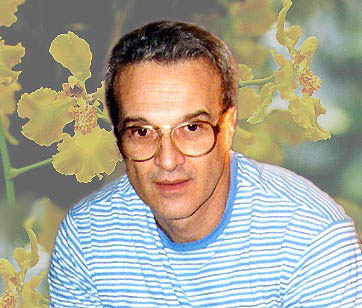

Interview with
Carlos Eduardo de Britto Pereira
A specialist in the genus Oncidium in Brazil.
Editor
of the Proceedings of the XV World Orchid Conference -
Brazil l996
 |
A specialist in the genus Oncidium in Brazil. Editor
of the Proceedings of the XV World Orchid Conference - |
||
|
For
many reasons, the genus Oncidium is considered as one of the most difficult
in Orchidaceae family. First of all, due to similarity between different
species, very often, one concludes that certain species occurs in two
different habitats but, in fact, they are two different species although
very closed. On the other hand, the variations inside the same species
brought, in the past and, occasionally still bring, to the description
of the same species under different names, provoking, in this way, an
artificial augmentation of the number of them. Finally, due to important
disparities existent between the different sections, this genus has
been frequently studying (including the utilization of DNA) and as a
result of those studies many species that we knew under the nomenclature
of Oncidium are nowadays classified in others genera. In order to understand
a little more about the species which occur in Brazil, we asked Carlos
Eduardo de Britto Pereira, chemist, researcher of the genus Oncidium
in Brazil and editor of the Proceedings of XV WOC, to do an explanation
about this genus in Brazil that will be published, integrally in our
virtual magazineOrchid News. Let's to the interview: ON: How is your history as orchidophile and orchidologist? Oncidium was your first interest? : CB: When I started to cultivate orchids, I did not even know what Oncidium was. In my sitting room, I have a bookshelf with two places to put plants. This bookshelf has been projected by an uncle who was a great architect. He has also projected the theatre of Copacabana Palace Hotel. I used to give parties in my place and just before one of them, I went to market and bought two pots of de Dendrobium and put them on of the bookshelf. Fifteen days later, I gave another party and bought two more. Friends concluded that I loved orchids, called me to spend a week-end in Petrópolis in order to know some nurseries. So I went to Binot for the first time, I was astonished and started to buy as a fool, every genus, Maxillaria, Laelia rupícola, I do not know what also and Oncidium. However something attracted me to Oncidium, may be because it is, sometime, a very small plant with an enormous spike, plenty of flowers. I decided to study this genus. I started to buy more and more Oncidium, I wanted all species. I looked for a book. I did not find. I decide to make one. How long have you been studying this genus?
I started 14 or 15 years before. I went to libraries and Botanical Garden
and when I went to the Library of the National Museum for the first
time, I told to the person who worked there that I was looking for a
book about Oncidium. I notice that you are very careful about when we ask you to identify an Oncidium species (mainly with photographs), you always say: - "It seems to be that species but I should study more before answer you". You also ask to bring a flower or the plant. I am plenty of doubts about the genus Oncidium. But those doubts arise from the knowledge because when someone does not know very well a subject, he does not even have a doubt. I think it comes from the knowledge, not from the want of knowledge. Just talking about terrestrial Oncidium, I mean, terrestrial and rupicolous because it is practically impossible to do a distinction between those two habits of growing, specially from Minas Gerais, I have 22 materials of liquid herbarium, which I did not succeed yet in identifying. I have to study more for defining if they are species already described or if new species which is perfectly possible. Look, for example, the rupicolous species of Laelia, intensively used in hybridization arise more attention than the Oncidium. The greater part of them has been describe recently, during Pabst's period, it means, not during the expeditions of the naturalists in the XIX century. They collected plants here and distributed to Europe to be described. Although, they went to 500 different places, the way they took in Minas Gerais was more or less the same. Not exactly the same because at this age, there were no roads, it was just tracks, pathway. Except for Saint Hilaire who went to southeast (he got down to São Paulo), Martius, Paul, Gardner, Warming (I studied about them because I did a lecture about this subject in Austria), all of them went to the region of Diamantina, habitat of many of those species of Laelia and have never found them. It is perfectly possible that the same thing had occurred with those species of Oncidium I had talked about because they come more or less of the same region. So you believe that we still have new species to be described, don't you? I am sure about three. One of them, Francisco was describing with me, it comes from the State of Rio de Janeiro. Another one comes from the State of Minas Gerais. I discovered it during a travel that I did with Francisco, I almost fell down from the rocks because of this Oncidium, it was a 200m high precipice. The plant had not flowers, I planted it in my place, in Friburgo, and it bloomed this year, in March. It is a beautiful Oncidium although very small. It is yellow, the callus of the lip is crimson with white drawings as they were mosaics. This species is certainly a new one. In which section, it could be inserted? Planifolia or verrucituberculata. The material has been collected, it is in alcohol but I have not studied yet because I am doing my thesis. There is another one that Augusto Burle sent me, it comes from south of the State of Bahia, assigned to Waluewa Section. There is another one, also assigned to the same section, coming from the State of Espirito Santo that I do not know if it has been already described. So, can we expect surprises in the genus Oncidium, with those news species, can't we? Yes but, any way, we should be very careful when we describe a new species. First of all, when you do something in taxonomy, you need to know the type, to visit herbariums where they are recorded. How could someone described a new specie without knowing the types of the other species already existent and recorded in European herbariums? It can lead to mistakes. Before describing a species botanist thinks it can be a new one, he should go to the herbariums, see the material-type of the species he thinks is closely related, verify the variations occuring and give a special attention to the callus mainly with the genus Oncidium. It is necessary to do a comparative study between the bibliography, the materials of reference and alive material of the species. The alive material should be exhaustively analyze in order to understand the variations existent and the limits of this species. You can not just think that it is a different thing and described as a new species. If it seems to be a certain species, you should compare with the population of this species because there many variations existent inside the same population. Concerning the terrestrial species, in the same spike, you can have different flowers, I am tired of seeing it, in a flower, one side of the callus is lacking, in others, the callus is more complex or simpler. In general, they are quite equal but there are those small variations. You can not consider different species only because of them. It does not occur only with the genus Oncidium. For instance, if you compare Cattleya labiata type to Cattleya labiata 'Emília', the later seems to be a hybrid. The normal Cattleya labiata is not upright like 'Emília'. Another example, Cattleya walkeriana called "cabeça de boi morto" (dead cow's skull), that is used to be put in the fence in the interior of the country. Almost all of them are like this but there are some other that are perfect, such as 'Feiticeira'. Many people say it is "made" however I have already see round Cattleya walkeriana coming from the wood. How could you say that is a another species only because of this? So, you consider that it is very important not only exhaustively study the alive material but also to visit herbariums, don't you?
It is fundamental, in order to avoid describe a plant that has already
been described with another name, otherwise it becomes a big mess in
taxonomy of orchids, specially concerning the genus Oncidium. Besides those visits, has you also visited many habitats? I went to the States of Minas Gerais, Rio and São Paulo. Paraná, I visited many times but regarding to what I need to do, it is not enough. In Minas Gerais, I went to many places but I need to go to more because to me, the origin of the species I need to investigate more is Minas Gerais.
|
||||
| Which region exactly in Minas? | ||||
Everyone, in the south of Minas, for example,
I need O. martianum which has been collected with O. maculosum by Martius, near to Poços de Caldas, Pouso Alegre. O. maculosum
I have already found there but O. martianum not yet. |
||||
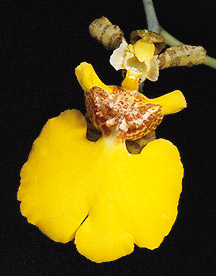 O. maculosum |
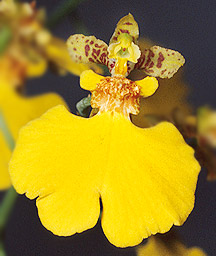 O. martianum |
|||
In the north of Minas there are many things,
many habitats, I know about others places where I have to go. For example,
when you go to Montes Claros, there is a mountain where you can see distant
rocks. I never went to there but I intend to. Minas Gerais is a big state,
we think it is small when we see in the map and we compare to Amazonas,
but it is very big, with many different systems and those plants which
occur on the rocks, sometimes are endemic to a restrict region. Those
places are very far from Rio and also between them. For example, I went
two times to Grão Mogol, in the north of Minas, looking for O.
isopterum, it is 1.100km far from Rio de Janeiro. The problem is not
only the time we expend but also it is very expensive. |
||||
|
Grão-Mogol is situated in a mountainous region? It is not so high as Diamantina although there are higher mountains. It is also Serra do Espinhaço but it is not so high. Where do you think the genus Oncidium is concentrated? Minas Gerais? Non, I should say State of Rio de Janeiro and Espírito Santo, Atlantic Forest. We can put in this way, Atlantic Forest could be the preferred habitat of the genus?
There
are many species but I would not say that. There are species from the
Atlantic Forest and there are species from drier regions, rupestrian
fields. But there also are rupestrian fields in Atlantic Forest. In
the middle of the wood, suddenly, there is a rock and a rupicolous field.
The new species from the State of Rio I have talked about, coming from
a rupicolous area like this. Can you imagine O. varicosum
growing in a rock? Can you imagine in the middle of the pasture land?
I have wonderful slides of those occurrences. A big plant flowering
in the middle of the pasture, under the grass, there was a rock. It
grew in the rock. We imagine an epiphyte plant and finally find it as
epiphyte and terrestrial in the same habitat. And O. crispum,
can you imagine growing in the rock too?
Very adaptable if you think in terms of epiphyte plants which can grow
as terrestrial (rupicola) or vice-versa. If I take warmer growing species
to my place in Friburgo (cool region), I will certainly kill the plant.
The same variety? And in the savannah (cerrado)? There are a few species, aren't there? Precisely in the cerrado, just a few, it is very dry. I just found O. cebolleta and in a place called "Water's eyes", you can conclude that there was a source , there is a lake with a small wood around, I found O. macropetalum. In fact, it is a micro climate although O. macropetalum comes from drier climate. O O. macropetalum is also found in more humid mountainous regions. Hoehne talked about it in his book "Iconografia das Orquidáceas do Brasil". And O. batemanianum, does it also occur in Goiás? In Goiás, I do not know, but it occurs in the region of Diamantina, Minas Gerais, in a dry place. The type comes from a place called Rio Grande.
In our researches, we found O. batemanianum, O. cebolleta,
O. chapadense although contested, O. orthostates,
O. fuscopetalum, O. hydrophilum, O. macropetalum,
O. pumilum, O. varicosum as occurring in the
State of Goiás. Can it be in savannah areas? |
||||
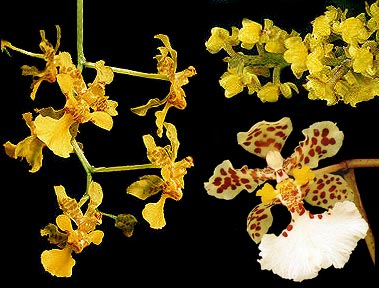
I have already found three species in a very dry rock: O. pumilum, O. cebolleta e O.jonesianum. |
||||
|
Have
you done a photographic register of your visits? |
||||
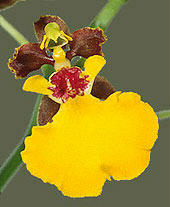
|
Other
species are not so characteristic as O. batemanianum or as O. spilopterum which are unmistakable plants. |
|||
On
the other hand, I think O. montanum is harder to be recognized
not exactly because of it self but because of those 22 material of herbarium
I have already talked about. Those terrestrial are very confused between
themselves. I found another species in Gouveia, at the beginning of Chapada
Diamantina, that I do not know what it is. It can be O. hydrophilum
or O. cipoense or another new species. The group is complicate. |
||||
|
If
you think about O. montanum,
it is already complicate, if you start to think about other species in the same group, the complication increases, O. caldense, O. ramosum, O. donianum, there are many species, all of them are really very similar. It is very complicated. |
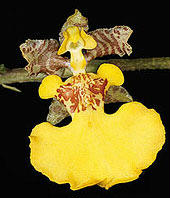 |
|||
| You mentioned O. cipoense, do you consider it as a valid species? I did not have the opportunity of studying this species yet so I do not know if the name is valid or not. Perhaps, it is a species, a synonym of O. hydrophilum, but it can not be. I do not know yet, I do not see the type nor the description. There are too few species described even in Orchidaceae Brasiliensis by Pabst & Dungs. Ecuador and Central America have many species and those regions are frequently visited by American botanists. There are 500 species and when you analyze you verify that there are small differences between them. Here, where we have so big differences, the species are not known because no one comes to do this. In my opinion, there many species to be described. As I have already said, those descriptions should be done based in consultation in herbariums and that is no good visit just one, you have to see the material is others herbariums too. And the Oncidium haematochrysum and O. haematoxanthum? In general, the former botanists used to correspond with each other and I have read that Reichenbach had sent to Lindley a drawing of O.haematochrysum, which he had described and one of O. haematoxanthum. Both are synonyms of O. flexuosum. I thought there were only two drawings but there are four or five big sheets of paper. I have a photocopy, it was hard to get it. 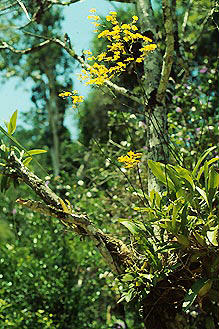 I can say that based on what I have already seen in those drawings, O. haematochrysum was practically identical to O. flexuosum however I just felt sure about when I went to the herbarium of Vienna and see the type O. haematochrysum. It is exactly equal to type of O. flexuosum described by Sims, in l821, it is the O. flexuosum. The variety haematoxanthum I have already found. It has a yellow-lemon pulvillus. The shape of the lip varies a lot in this species, it can be tetralobe or not. The front lobe of the lip also presents in different shapes. The important is the callosity, those small needles and the small pulvillus it has which starts above the callus, near the column, in general reddish. Oncidium is hard, you know? I have already found O. rivierianum, that I thought it was non-existent. Where did you find it? In Orquidário Binot, there was a shelf in the end of the nursery which I called cemetery. Plants that they could not identify or those which were dying, they put there. I have bought many cheap plants there even if they were dying because as they were Oncidium, they interested me, I bought expecting saving them. Concerning the O. rivierianum, unfortunately I do not know where it came from, I do not have photograph but I have herbarium material. I used to take plants to be photographed by a professional photographer but it became so expensive that I should stop it. The photograph fixed an appointment but he did not come and I lost the flower. The flower faded away, the plant died because when I bought it was dying . There I also found O. paranaense. It was the only I have seen, it has a very small flower, folded, it is funny, but it is pretty, it not ugly. The only Oncidium that does not attract me is O. aberrans, I brought it from Paraná. The flower is very small, it is not a "fat" inflorescence like O. pumilum, which is beautiful. Do you know O. schwambachii which occurs in Espírito Santo, it is white with a yellow small callus, very perfumed, similar to O. pumilum e O. morenoi?
No,
I do not know. There is a enormous quantity of synonyms and very often,
we feel confused. Have you find that information in Pabst? Mainly in Pabst but there are other more recent publications about new species and the modifications. However you should not forget that after the publication of Orchidaceae Brasiliensis, bu Pabst & Dungs, some valid species have been described, for example, O. schunkeanum and O. majevskyi. |
||||
|
According
to Francisco Miranda, in his book "Orchids from the Brazilian Amazon",
in that region, there are few species but not many. |
||||
|
O. papilio, in Acre, O. urophyllum (nowadays Tolumnia
urophylla) from Oncidium section, reported to the state of
Amazonas. I do not yet confirm this occurrence as the two times I received
material to examine when they bloomed, there were Ionopsis.
|
||||